Trees of New York City
The land comprising New York City holds approximately 5.2 million trees and 168 different tree species, as of 2020.[1] The New York City government, alongside an assortment of environmental organizations, actively work to plant and maintain the trees.[1] As of 2020, New York City held 44,509 acres of urban tree canopy with 24% of its land covered in trees.[1][2]
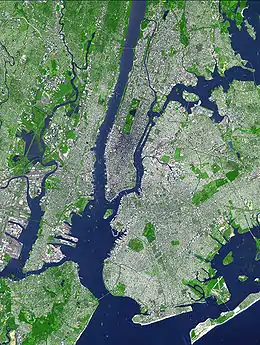
History of trees in New York City
Trees have grown continuously on the mainland and islands that now comprise New York City since the end of the Pleistocene epoch.[3] Trees have inhabited the lands in or around what is now New York City for over 300 million years, far before the existence of humanity.[3] The first human settlement in the NYC area is dated as early as 9,000 years ago, this marked the beginning of human's permanently altering the old-growth forest ecosystem.[4]
Humanity's impact of the trees in New York City greatly accelerated with European colonization of the Americas as the new settlers brought with them advanced metal tools and tree processing technologies paired with an appetite for lumber for domestic use and for export to others of the Thirteen Colonies and to the Old World.[5] While the Native American population lived off and with the Northeastern coastal forests relatively symbiotically, the new European colonists, with their higher population density, sedentary housing needs, and agriculture techniques, diminished the need to harvest wild fruits from trees.[5] The New World found itself rapidly deforested, New York City included.[5]
Native American use of trees
The Lenape peoples who inhabited the greater NYC area directly prior to European colonization relied on trees for food, shelter, tool materials, fuel, and medicine.[6] The typical Lenape house, called a longhouse, relied on the bending of the trunks taken from small trees to create a series of arches to serve as the frame.[6] The Lenape used the Zanthoxylum tree as medicine for toothaches because chewing on the leaves or bark creates a tingling, or numbing effect in the mouth.[7]
In 1624, at the time of the founding of New Amsterdam, huge stands of Oak, Hickory, and Chestnut trees grew throughout the island of Manhattan.[8] The very name "Manhattan" is recorded as originally referring to a stand of hickory trees with wood suitable for bow-making, located at the southern tip of the island. At this time, the area now known as Times Square was a Red Maple swamp.[8] The Lenape called Governors Island: “Pagganck,” which means “nut island,” named after the areas abundance of hickory nut trees.[3]
Native Americans made use of fire in ecosystems here as elsewhere, and some of the early Dutch colonists copied this practice.[9]
The original forests and ecosystems of 1609 Manhattan have been reconstructed by the Wildlife Conservation Society's Mannahatta Project.[10]
Colonial use of trees
Fruit trees imported during the Dutch period included apple, cherry, peach and pear planted in prominent orchards.[11]
At the corner of Cherry Street and Franklin Square, was the "Cherry Garden" planted by David Provost Sr.,[12] and later operated by the brewer Richard Sackett as "Sackett's Orchard" with a beer garden and bowling green.[13] George Washington later lived at 1 Cherry Street, the location being notable as the nation's first presidential residence.[3] Remnants of the orchard survived into the 1870s, when the last of the trees and Washington's home at 1 Cherry Street, were razed to build the Brooklyn Bridge.[3]
Lumber in Manhattan during the Dutch period was largely processed at the Sawkill saw mill, worked by a settlement of enslaved Africans.[14]
Contemporary use of trees
In New York City, the harvesting of trees for lumber and the maintaining of orchards for fruit declined as forests and farmland was bought and developed to house the growing population of the city.[15] Since the late 19th-early 20th century, the functions of the trees planted in the urban landscape and parks of New York City is to provide shade, help manage rainwater runoff, and clean the air by absorbing some of the carbon dioxide produced by New York City's 18+ million residents.[16]
In an effort to maintain and improve its urban forest, New York City runs tree planting efforts through the Parks Department.[17] As of 2020, New York City Department of Parks and Recreation is the steward of most of the 2.5+ million trees growing within New York City.[18] The New York City Tree Map is an interactive map by the parks department that catalogues more than 850,000 trees in the city.[19]
The NYC Department of Parks observes Earth Day and Arbor Day.[18]
Street trees as a metaphor for urban life were popularized in the 1943 novel A Tree Grows in Brooklyn.[20]
The tallest and oldest tree in New York City is a Tulip Poplar growing in Queens named the Queens Giant.[21]
Between 2010 and 2017, the city's tree canopy increased by 1.7%.[22][23]
Old-growth forests
Tracts of trees that have been characterized as old-growth forest include the Thain Family Forest at the New York Botanical Garden (largest in the city), as well as parts of Hunter Island in Pelham Bay Park, Midwood Forest in Prospect Park, Northwest Woods in Van Cortlandt Park, Shorakapok Preserve in Inwood Hill Park, Alley Pond Park and Forest Park.[24] A number of the old growth forests in New York City are preserved as Forever Wild preserves.[25]
Notable trees
In 1985, a community nominations process led to the selection of sixty-five "Great Trees",[26][27] and in the 21st century some of these were cloned through cuttings.[28][29]
Notable living trees
| Name | Type | Location | Borough | Notes |
|---|---|---|---|---|
| Queens Giant | Tulip poplar | Alley Pond Park | Queens | A 134+ foot tall tulip poplar tree, believed to be the tallest and oldest tree in the city[21][30] |
| Clove Lakes Colossus | Tulip poplar | Clove Lakes Park | Staten Island | A 119+ foot tall tulip poplar tree with 21+ foot circumference[30] |
| Hangman's Elm | English elm | Washington Square Park | Manhattan | Planted in the 1790s. Believed to be the oldest tree in Manhattan.[31] It was rumored to be where traitors were hanged during the American Revolution, but this was determined to be unfounded.[32] The only recorded execution in this area was of Rose Butler, in 1820, who was hanged from a gallows in the city's potter's field about 500 feet from the elm.[33] |
| Magnolia grandiflora at 677 Lafayette Avenue | Magnolia grandiflora | Bedford–Stuyvesant | Brooklyn | A rare example of a flourishing laurel magnolia growing far north in New York, brought as a seedling from North Carolina and planted around 1885 by William Lemken. A New York City designated landmark[34] |
| Survivor Tree | Callery pear | National September 11 Memorial | Manhattan | A Callery pear tree that survived the September 11, 2001 terror attacks at the World Trade Center. Taken off-site and nursed back to health by the NYC Parks department, the Survivor Tree was returned and replanted at the memorial site in 2010.[35] |
| Camperdown Elm (Marianne Moore) | Camperdown Elm | Prospect Park | Brooklyn | Planted in Prospect Park in 1872, a descendant of a unique growing Elm species from the Earl of Camperdown's Scottish estate. Among the first planted in the United States.[36][37] |
| James Madison Tree | Red Oak | Madison Square Park | Manhattan | A Red Oak grown on James Madison's estate in Virginia and transplanted in 1936 at Madison Square Park to celebrate the 100th anniversary of Madison Avenue.[38] |
| The Dinosaur | English elm | Washington Heights | Manhattan | English elm tree, planted on the estate of the Morris Jumel Mansion in the early 18th century. George Washington allegedly stood under the tree on September 21, 1776, to watch the fire set by American rebels that burnt much of New York City.[39] |
| Boss Tweed Ginkgo | Ginkgo | Crocheron Park | Queens | A 150+ year old Ginkgo tree, alleged witness to Boss Tweed’s escape from the United States.[40] |
| Hare Krishna Tree | American elm | Tompkins Square Park | Manhattan | An American elm where the “Hare Krishna” mantra was chanted publicly in 1966 for the first time outside of India, marking the birth of the Hare Krishna movement in the West.[41] |
| Woodside Beech Tree | Beech | Woodside | Queens | A large beech tree estimated to be between 150 and 200 years old.[42] |
Notable deceased trees
| Name | Type | Location | Borough | Notes |
|---|---|---|---|---|
| Weeping Beech | Weeping beech | Flushing | Queens | The original weeping beech tree located in Flushing was the mother of all European weeping beeches in the United States. After the original died in 1998, the location was replanted with new weeping beech trees. Even though the original is no longer living, the tree remains a New York City designated landmark.[43] |
| Gran Bwa | Unidentified large stump | Prospect Park | Brooklyn | A large tree stump formerly located by the lake in Prospect Park. The stump was carved into a sculpture and named after Gran Bwa, the Haitian Vodou spirit associated with trees. The Gran Bwa sculpture depicted a big human head, two small human faces, a lion and a legba. The stump was sculpted in the 1980s by a Haitian immigrant Deenps Bazile.[44] Communities and individuals recreating and worshipping in Prospect Park appreciated the tree stump sculpture until its removal.[44] The Haitian community gathered and still gathers at the Gran Bwa location to celebrate Bwa Kayiman.[44] |
| Tree of Hope | Elm | Lafayette Theatre, Harlem | Manhattan | Once considered the most famous tree in Harlem, the Tree of Hope was an elm tree growing outside the Lafayette Theatre in Harlem in 132nd Street, that musicians would touch for good luck. In 1933, part of the stump of the Tree of Hope was removed and gifted to the Apollo Theater, where it sat next to the stage until ultimately moved to the lobby following a renovation.[45] According to a report in the New York Herald Tribune, the tree got its name from a group of actors recently fired from a show that had gone bankrupt. Owed back pay, the group gathered at the tree of hope, hoping to see the manager and recoup their wages. Eventually the actors received $6.43 in back pay. Inspired by the success of the actors, the tree became a meeting spot for actors in search of work. The actors and performers who rubbed the Tree of Hope for good luck included: Bojangles Robinson, Aubrey Lyles, Flournoy Miller, and many others. In 1941, Bojangles Robinson worked with mayor Fiorello La Guardia to plant a replacement tree in the old location of the Tree of Hope.[46][47] |
| Inwood Tulip Tree at Shorakapkok | Tulip poplar | Inwood Hill Park | Manhattan | A large Tulip Tree that grew to the height of 165 feet and a girth of 20 feet. The tree died 1932, at the estimated age of 220 years old. Some saw the tree as a last remaining link to the Wecquaesgeek who lived amongst the tree at Shorakapok.[48] A small monument now stands where the tree once grew.[48] |
| Stuyvesant Pear Tree | Pear tree | Stuyvesant Farm, East Village | Manhattan | In 1647, Peter Stuyvesant, the Dutch colonial governor, planted a pear tree on his farm, Stuyvesant Farm.[49] It stood here for two hundred years, with New York City growing around it. The 1811 street grid covered over the farm but spared the Stuyvesant Pear Tree. The tree remained there until February 1867, weakened by a massive winter storm and done in by a wagon collision.[49] A plaque marking the Stuyvesant tree's spot remains at the corner of 13th Street and Third Avenue.[49] In this neighborhood, pear trees are still planted to commemorate the original pear tree planted by Stuyvesant.[50] A Stuyvesant descendant gifted a cross-section of the original trunk to the New-York Historical Society.[50] |
| Dongan Oak | White oak | Battle Pass, Prospect Park | Brooklyn | The Dongan Oak was a boundary tree felled and used as a barricade by the American defenders against the northward invasion during the American Revolutionary War. The stump of the Dongan Oak was still recorded in the 1840s, and it may have been destroyed in the landscaping that created Prospect Park, when parts of the hills were also leveled.[51] The tree is believed to have been 100+ years old at the time the Colonial soldiers cut it down.[51] |
| Wall Street Buttonwood Tree | Buttonwood | Financial District | Manhattan | The Buttonwood Agreement, which established what is now the New York Stock Exchange, was signed in 1792 under this tree.[52] |
| Thirteen Union Trees | Sweetgum trees | Hamilton Grange, St. Nicholas Park | Manhattan | Thirteen sweet gum trees planted ~ 1802 by Alexander Hamilton, growing near the entrance of his Hamilton's home, the Grange. The thirteen trees symbolized the original thirteen states of the Union. The trees were cut down in December, 1908.[53] |
| Woodside Chestnut Tree | American chestnut | Woodside | Queens | An ancient chestnut tree that grew in what would become Woodside, Queens. The large tree served as a legal meeting place and town square for the town of Newtown and later Woodside. The large tree is said to have been 8 to 10 feet in diameter.[54] |
| Treaty Tree | Oak | Bartow-Pell Mansion, Pelham Bay Park | The Bronx | An oak tree reported to be the location of a treaty signing in 1654 between Thomas Pell, an English settler, and Chief Wampage of the Siwanoy Indians declaring peace and granting large swathes of land to Pell. The truthfulness of this legend is in question with some scholars questioning the origin and motivation of the Treaty Tree and other treaty trees believing them to be propaganda promoting the narrative of peaceful colonial settlement.[55] The name of Treaty Tree was giving to this historic tree later in its life and only after Native American archaeological artifacts were found nearby, further fueling speculation that the history surrounding the Treaty Tree name is inaccurate.[56] The historic tree died and was replaced in 1915. The replacement was replaced in 2015.[57] |
| Fox Oaks | Oak | John Bowne House, Flushing | Queens | A grove of oak trees that stood in Flushing, Queens. During a Quaker meeting in 1672 featuring the newly arrived George Fox, the founder of the Religious Society of Friends in England, Fox's popularity drew such a large crowd, that they could not fit into the John Bowne House.[58] The group moved the meeting outside, holding the meeting under the grove of oaks. The trees lived until the mid-to-late 19th century. A rock monument now stands where the trees once lived.[58] |
| Flushing Cedar of Lebanon | Cedar of Lebanon | Flushing | Queens | Once the pride of Flushing, the 200+ year-old Lebanese cedar tree was killed by lightning in 1934. A Lebanese cedar tree grows at Weeping Beech Park, Flushing, Queens. The likely relative of the Flushing Cedar of Lebanon was grown at the 19th-century nursery of Samuel Parsons.[59] |
| Twelve Apostles | Beech trees | Bay Ridge | Brooklyn | A grove of 12 old-growth beech trees estimated to be over 200 years old in 1912. When 75th street was expanded to the shore, the new road ran through the grove.[60] The grove stood until the Jacobus family sold the land. In the early 20th century, an apartment building was built on the site and the trees were destroyed.[61] |
Trees growing in New York City
For a full list including street trees of New York City, as well as trees planted in New York City parks and public spaces, see this article: list of tree species of New York City.[62][63][64][65][66]
10 most common street trees in New York City
| Scientific name | Common name | Photo | Size | Native
species |
% of NYC street trees
(data from 2006)[67] |
|---|---|---|---|---|---|
| Platanus × acerifolia | London planetree |  |
Large | Non-Native | 15.3% |
| Acer platanoides | Norway maple |  |
Large | Non-Native, Invasive[68] | 14.1% |
| Pyrus calleryana | Callery pear | 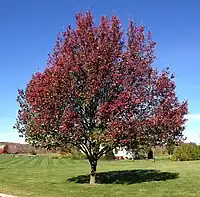 |
Medium | Non-Native | 10.9% |
| Gleditsia triacanthos inermis | Honey locust | 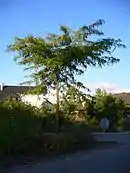 |
Large | Non-Native | 8.9% |
| Quercus palustris | Pin oak | 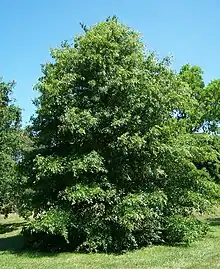 |
Medium | Native | 7.5% |
| Tilia cordata | Littleleaf linden |  |
Large | Non-Native | 4.7% |
| Fraxinus pennsylvanica | Green ash | 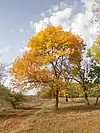 |
Medium | Native | 3.5% |
| Acer rubrum | Red maple |  |
Large | Native | 3.5% |
| Acer saccharinum | Silver maple | .jpg.webp) |
Large | Native | 3.2% |
| Ginkgo biloba | Ginkgo | 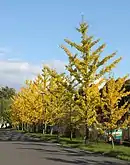 |
Large | Non-Native | 2.8% |
Arboreta in New York City
| Arboretum | Address | Borough | Latitude & Longitude | Accredited Arboretum Status |
|---|---|---|---|---|
| Arthur and Janet Ross Conifer Arboretum | 200th Street & Kazimiroff Blvd., Bronx, New York, 10458, United States | Bronx | 40.871910°N 73.887840°W | |
| Brooklyn Botanic Garden | 1000 Washington Avenue, Brooklyn, New York, 11238, United States | Brooklyn | 40.667604°N 73.961826°W | III[69] |
| Fordham University | 441 E. Fordham Road, Bronx, New York, 10465, United States | Bronx | 40.861280°N 73.889720°W | |
| Green-Wood | 500 25th Street, Brooklyn, New York, 11232, United States | Brooklyn | 40.658116°N 73.994661°W | III[70] |
| Madison Square Park Conservancy | 11 Madison Avenue 15th Floor, New York, New York, 10010, United States | Manhattan | 40.741590°N 73.987380°W | II[71] |
| New York Botanical Garden | 2900 Southern Blvd., Bronx, New York, 10458, United States | Bronx | 40.871910°N 73.887840°W | |
| The Evergreens Arboretum | 1629 Bushwick Avenue, Brooklyn, New York, 11207, United States | Brooklyn | 40.684070°N 73.903430°W | II[72] |
| The Woodlawn Cemetery | 4199 Webster Avenue, Bronx, New York 10470, United States, | Bronx | 40.887833°N 73.867574°W | II[73] |
References
- "MillionTreesNYC – NYC Tree Facts". www.milliontreesnyc.org. Retrieved 2020-04-24.
- Foderaro, Lisa W. (2011-10-18). "As City Plants Trees, Some Say a Million Are Too Many". The New York Times. ISSN 0362-4331. Retrieved 2020-04-24.
- "How Science Reconstructs the Evolution of Trees and Forests". ThoughtCo. Retrieved 2020-04-24.
- "Remains of Earth's oldest forest found in New York | EarthSky.org". earthsky.org. 20 December 2019. Retrieved 2020-04-24.
- Buck, Stephanie (2017-08-22). "The first American settlers cut down millions of trees to deliberately engineer climate change". Medium. Retrieved 2020-04-24.
- "Facts for Kids: Lenni Lenape Indian Tribe (Delaware Indians, Lenapes)". www.bigorrin.org. Retrieved 2020-04-24.
- "The Truth About Trees". Urban Omnibus. 2019-03-13. Retrieved 2020-04-24.
- Sullivan, Robert (2009-05-22). "Island in the Stream". The New York Times. ISSN 0362-4331. Retrieved 2021-05-05.
- Russell, Emily W. B. (1983). "Indian-Set Fires in the Forests of the Northeastern United States". Ecology. 64 (1): 78–88. doi:10.2307/1937331. ISSN 0012-9658. JSTOR 1937331.
- Lamb, Juliet (2016-09-08). "What Did Manhattan Look Like in 1609?". JSTOR Daily. Retrieved 2021-09-03.
- "History of Fruit Growing in the Hudson Valley » The Jentsch Lab". blogs.cornell.edu. Retrieved 2021-09-03.
- Innes, J. H. (John H. ) (1902). New Amsterdam and its people; studies, social and topographical, of the town under Dutch and early English rule. The Library of Congress. New York, C.Scribner's sons.
- Stokes, Isaac Newton Phelps (1922). The Iconography of Manhattan Island, 1498–1909. R. H. Dodd.
- Stokes, I.N. Phelps (1998). The Iconography of Manhattan Island, 1498–1909 : compiled from original sources and illustrated by photo-intaglio reproductions of important maps, plans, views, and documents in public and private collections. Mansfield Centre, Conn. Union, N.J: Martino Fine Books Lawbook Exchange. ISBN 978-1-886363-30-4. OCLC 37341474.
- "The Last Working Farm". 3 January 2009.
- "NYC's Urban Forest". Million Trees NYC.
- "Voluntary Local Review New York City's Implementation of the 2030 Agenda for Sustainable Development" (PDF). Mayor's Office. July 2018.
- "History of Earth Day & Arbor Day in Parks : NYC Parks". www.nycgovparks.org. Retrieved 2021-01-10.
- Poon, Lisa (9 December 2022). "New York City's Popular Online Tree Map Gets a Big Update". Bloomberg News. Retrieved 10 December 2022.
- Berger, Meyer (1943-08-22). "Green Sunless Weed; A Tree Grows in Brooklyn. By Betty Smith. 443 pp. New York: Harper & Brothers. $2.75". The New York Times. ISSN 0362-4331. Retrieved 2021-09-03.
- Simon, Jordan (2015-02-20). "This is the Oldest and Tallest Tree In NYC: The Queens Giant in Alley Pond Park". Untapped New York. Retrieved 2021-01-10.
- The study "NYC LiDAR". maps.nyc.gov. The dataset "Tree Canopy Change (2010 - 2017)". NYC Open Data. illustrates these changes.
- Holliday Smith, Rachel (12 November 2021). "First NYC Tree Canopy Study Shows Growth as Storms and Budget Cuts Threaten Gains". The City. Retrieved 22 March 2023.
- "New York City's Hidden Old-Growth Forests". State of the Planet. 2021-08-02. Retrieved 2021-09-03.
- Stewart, Barbara (2002-07-13). "Just Off the Expressway, Ancient New York; Remnants of Virgin Forests Still Stand, Even in the Bronx and Queens". The New York Times. ISSN 0362-4331. Retrieved 2021-09-06.
- "Great Trees : NYC Parks". www.nycgovparks.org. Retrieved 2021-06-05.
- Meier, Allison C. (2017-04-17). "On the Trail of New York's Greatest Trees". Bloomberg CityLab. Retrieved 2021-06-05.
- "Van Cortlandt Park News – Return Of The Clones! NYC Parks To Plant Historic "Great Tree" Clones Across New York City : NYC Parks". www.nycgovparks.org. Retrieved 2021-06-05.
- Sutton, Michelle (2014-06-10). "Historic "Great Trees" Returning to NYC". New York State Urban Forestry Council. Retrieved 2021-06-05.
- Crewdson, Michael; Mittelbach, Margaret (2000-11-10). "A Rendezvous With 2 Giants". The New York Times. ISSN 0362-4331. Retrieved 2021-06-05.
- "The Hangman's Elm". Atlas Obscura.
- "New York: A Concrete Jungle And 'City Of Trees,' Too". NPR.org. Retrieved 2021-06-05.
- Warner, Laceye C. (March 3, 2017). Saving Women: Retrieving Evangelistic Theology and Practice. Baylor University Press. ISBN 9781932792263.
- "Magnolia grandiflora, 679 Lafayette Avenue" (PDF). New York City Landmarks Preservation Commission. 1977-05-12. Retrieved 2020-04-28.
- "The Survivor Tree | National September 11 Memorial & Museum". www.911memorial.org. Retrieved 2021-06-14.
- "The Results Are In! Prospect Park Tree Survey". Prospect Park. September 14, 2018. Retrieved February 5, 2019.
- "Prospect Park Great Trees : NYC Parks". New York City Department of Parks & Recreation. June 26, 1939. Retrieved February 5, 2019.
- "Madison Square Park Monuments – James Madison Tree Marker : NYC Parks". www.nycgovparks.org. Retrieved 2021-06-15.
- "Great Trees : English Elm : NYC Parks". www.nycgovparks.org. Retrieved 2021-06-17.
- Short, Aaron (2016-08-14). "These are the oldest — and tallest — trees in New York City". New York Post. Retrieved 2021-06-17.
- "Hare Krishna Tree". Atlas Obscura. Retrieved 2021-06-17.
- "Tree That May Date to Revolution Deserves Landmark Status, Advocates Say". DNAinfo New York. Archived from the original on 2021-06-29. Retrieved 2021-06-17.
- "The Weeping Beech Tree" (PDF). New York City Landmarks Preservation Commission. April 19, 1966. Retrieved January 20, 2020.
- "Prospect Park Alliance Celebrates Black History Month". Prospect Park. 19 February 2020. Retrieved 2021-06-22.
- Williams, Timothy (2008-07-05). "Coda Is Heard for a Daytime Jazz Club in Harlem". The New York Times. ISSN 0362-4331. Retrieved 2021-06-29.
- Aberjhani; West, Sandra L. (2003). Encyclopedia of the Harlem Renaissance. Infobase Publishing. ISBN 978-1-4381-3017-0.
- Worth, Richard (15 July 2020). Black Culture in Bloom : The Harlem Renaissance. Rosen Publishing Group, Incorporated. ISBN 978-1-7253-4199-9. OCLC 1143618648.
- "Inwood Hill Park Monuments – Tulip Tree : NYC Parks". www.nycgovparks.org. Retrieved 2021-06-29.
- Shah, Vivek (2013-08-22). "Getting Into the Roots of Manhattan Through a History of its Famous Trees". Untapped New York. Retrieved 2021-01-10.
- "The Stuyvesant Pear Tree: New York City Mourns the Loss of its "Oldest Living Thing"". New-York Historical Society. 2017-02-22. Retrieved 2021-01-10.
- "Prospect Park Monuments – Dongan Oak Marker : NYC Parks". www.nycgovparks.org. Retrieved 2021-06-22.
- Banner, Stuart (January 1998). "The Origin of the New York Stock Exchange, 1791–1860". The Journal of Legal Studies. The University of Chicago Press. 27 (1): 113–140. doi:10.1086/468015. JSTOR 10.1086/468015. S2CID 154599743.
- "New York City EcoFlora" (PDF). NYBG.
- "Woodside, Queens (History) – UrbanAreas.net". urbanareas.net. Retrieved 2021-06-30.
- "Monuments of Colonial New York: The Tulip Tree and 'Signal'". The Gotham Center for New York City History. 12 October 2020. Retrieved 2021-07-01.
- Douglas, Peter A. (April 2009). "The Native Place of Manhattan: Where Did the Manhattan "Purchase" Take Place?" (PDF). New Netherland Institute.
- "Today in NYC History: Historic Treaty Oak Re-Planted at Bartow-Pell Mansion, Bronx". Untapped New York. 2015-05-01. Retrieved 2021-06-29.
- "Queens Public Library Digital". digitalarchives.queenslibrary.org. Retrieved 2021-06-29.
- "The Greatest Trees of NYC". The Greatest Trees of NYC. Retrieved 2021-06-22.
- Bangs, Charlotte Rebecca Woglom (1912). Reminiscences of Old New Utrecht and Gowanus. Brooklyn Eagle Press. ISBN 978-0-598-54458-2.
- "Why Does Bay Ridge Have Fancy Names for First and Second Avenues? | Hey Ridge". 28 March 2016. Retrieved 2021-06-21.
- "Street-Trees-List-For-Permits" (PDF). NYC parks.
- "Street Tree Planting Approved Species List : NYC Parks". www.nycgovparks.org. Retrieved 2020-04-24.
- "NYC Street Tree Map". NYC Parks. Retrieved 2020-04-24.
- "An Interactive Visualization of NYC Street Trees – A Project by Cloudred". An Interactive Visualization of NYC Street Trees. Retrieved 2020-04-24.
- "Behold the New York City Street Tree Map: An Interactive Map That Catalogues the 700,000 Trees Shading the Streets of New York City". Open Culture. October 23, 2019. Retrieved 2020-04-24.
- "Trees Count! Street Tree Census : NYC Parks". www.nycgovparks.org. Retrieved 2021-06-30.
- "Research Guides: Invasive Plants: Invasive Plants". New York Botanical Garden. Retrieved 2021-06-03.
- "Arbnet - Brooklyn Botanic Garden". www.arbnet.org. Retrieved 11 May 2022.
- "Arbnet - Green-Wood". www.arbnet.org. Retrieved 11 May 2022.
- "Arbnet - Madison Square Park Conservancy". www.arbnet.org. Retrieved 11 May 2022.
- "Arbnet - The Evergreens Arboretum". www.arbnet.org. Retrieved 11 May 2022.
- "Arbnet - The Woodlawn Cemetery". www.arbnet.org. Retrieved 11 May 2022.